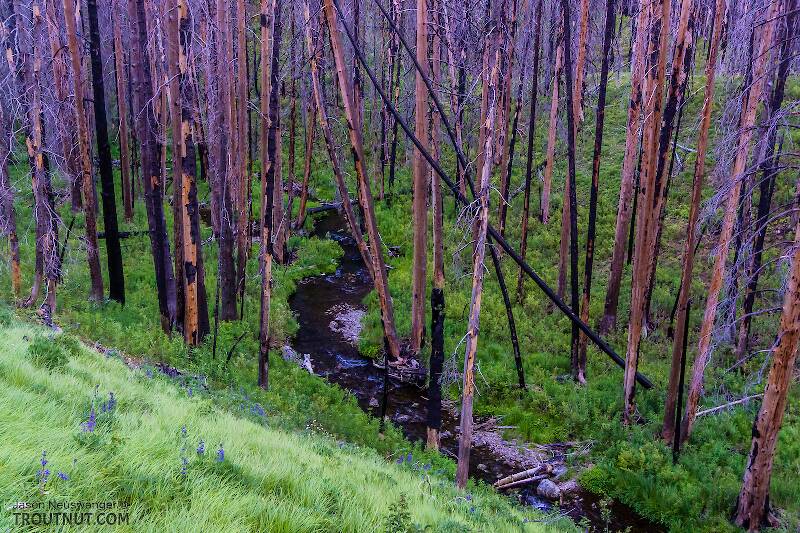
Salmonflies
Pteronarcys californica
The giant Salmonflies of the Western mountains are legendary for their proclivity to elicit consistent dry-fly action and ferocious strikes.


Mayfly Species Ephoron leukon (White Flies)
On page 243 of Hatches II there is a passage from an 1802 speech before the American Philosophical Society in which this mayfly was introduced to science. It was the first mayfly species described in the United States, so it is ironic that it went unnoticed through so many of the early decades of our sport.
Where & when
This is the only Ephoron species producing significant hatches in the East, and it overlaps with Ephoron album in the Midwest.In 27 records from GBIF, adults of this species have mostly been collected during August (41%), July (26%), September (15%), and June (11%).
In 1 record from GBIF, this species has been collected at elevation of 618 ft.
Species Range
Identification
Quoting The Biology of Mayflies regarding the adults:This species differs from E. album in the deep red-brown mesonotum; smoky pronotum and reddish brown markings on pleura and sternum; darker fore legs; area of dark cross veins in fore wing more extensive; tails darker; tergites shaded with grey. The body, in individuals measured, is slightly longer.
Physical description
Most physical descriptions on Troutnut are direct or slightly edited quotes from the original scientific sources describing or updating the species, although there may be errors in copying them to this website. Such descriptions aren't always definitive, because species often turn out to be more variable than the original describers observed. In some cases, only a single specimen was described! However, they are useful starting points.
Male Spinner
Wing length: 11–12 mm
Vertex of head yellowish brown, heavily shaded with purplish black between ocelli; mesonotum largely dark reddish brown; veins of costal margin of fore wing purplish, cross veins of median and cubital areas greyish lavender. Face yellowish; antennae pale whitish, faint grey shading at apex of second joint; eyes black. Vertex yellowish to pale reddish brown, heavily shaded with purplish black between ocelli, often with faint brown shading near posterior margin; bases of ocelli heavily black-ringed. Pronotum yellowish brown, tinged distinctly with purplish grey in median area; reddish brown shading laterally; purplish grey streaks and shading above base of fore leg. Mesonotum dark red-brown in anterior and median portions; posterior portion anterior to and laterad of scutellum pale yellowish; scutellum smoky; sutures and a narrow median line blackish, except in anterior portion, where median line is yellow. Metanotum red-brown, scutellum dark smoky. Pleura yellowish with red-brown areas anterior to middle leg and below wing roots; sternum yellow, washed with red-brown in median area. Fore femur and tibia deep purple, the femur with whitish areas along ventral edge and near middle of outer surface; tarsus paler, purplish grey. Middle and hind femora yellowish, tibiae and tarsi whitish. Wings as in E. album Say, but both longitudinal and cross veins of costal margin are darker, cross veins appearing blackish in some lights; cross veins as far back as the anal region are purplish grey, becoming fainter and paler posteriorly. Abdomen yellowish white; basal and middle segments often semi-hyaline; segments 8-10 yellowish with tinge of red, the tergites washed with purplish grey except on lateral margins, this shading deepest in median area and anterior margin. Middle tergites with a greyish median streak, sometimes faintly seen also on basal tergites; occasional traces also of grey shading laterally. Genitalia pale; tips of penes and tip of long joint of forceps dusky. Tails rather deep purplish at base, becoming pearly grey in median area, tips whitish; joinings opaque white.
Discussions of Ephoron leukon
Start a Discussion of Ephoron leukon
References
- Caucci, Al and Nastasi, Bob. 2004. Hatches II. The Lyons Press.
- Jacobus, L. M., Wiersema, N.A., and Webb, J.M. 2014. Identification of Far Northern and Western North American Mayfly Larvae (Insecta: Ephemeroptera), North of Mexico; Version 2. Joint Aquatic Science meeting, Portland, OR. Unpublished workshop manual. 1-176.
- Merritt R.W., Cummins, K.W., and Berg, M.B. 2019. An Introduction to the Aquatic Insects of North America (Fifth Edition). Kendall/Hunt Publishing Company.
- Needham, James G., Jay R. Traver, and Yin-Chi Hsu. 1935. The Biology of Mayflies. Comstock Publishing Company, Inc.
Mayfly Species Ephoron leukon (White Flies)
Species Range
Common Names
Resources
- NatureServe
- Integrated Taxonomic Information System
- Global Biodiversity Information Facility
- Described by Williamson, Hugh. 1802. On the Ephoron leukon, usually called the white fly of Passaick River. Transactions of the American Philosophical Society 5: 71-73.

